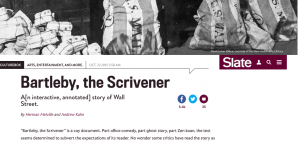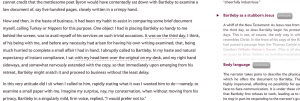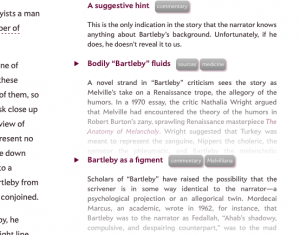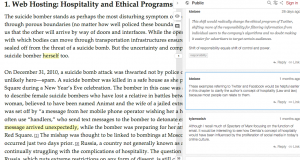Title: Bartelby the Scrivener: A[n interactive, annotated]story of Wall Street.
Author: Andrew Kahn (and Herman Melville)
Publication: Slate
Release Date: October 22, 2015
Website: http://www.slate.com/articles/arts/culturebox/2015/10/
herman_melville_s_bartleby_the_scrivener_an_interactive_annotated_text.html
This webtext-of-the-month takes Slate’s recent experiment with interactive annotations as an opportunity to consider the pedagogical affordances of digital annotation. In the piece, Slate’s  Andrew Kahn reproduces the entire text of Herman Melville’s famously opaque short story, “Bartelby, the Scrivener,” weaving digitally embedded annotations throughout. The annotations allow Kahn to insert his own textual analyses and bite-sized snippets of scholarly commentary. The annotations are “interactive” in that they can be filtered by theme, which range from “history” and “economics” to “modern” and “queer,” allowing the reader to choose which annotations to make visible.
Andrew Kahn reproduces the entire text of Herman Melville’s famously opaque short story, “Bartelby, the Scrivener,” weaving digitally embedded annotations throughout. The annotations allow Kahn to insert his own textual analyses and bite-sized snippets of scholarly commentary. The annotations are “interactive” in that they can be filtered by theme, which range from “history” and “economics” to “modern” and “queer,” allowing the reader to choose which annotations to make visible.

This use of digital annotation isn’t novel, and in fact this approach has increasingly been adopted in academic and popular digital spaces using open-source tools like Genius and Hypothes.is. But its increasing (if not yet quite ubiquitous) presence raises some interesting questions about its rhetorical effect on readers. On the one hand, what kind of reading experience and engagement do texts like these, in their already-annotated state, engender? On the other, what kind of a reading practice does this process of annotation model and make evident?
I’d like to suggest that the already-annotated text (like Kahn’s “Bartelby”) is good for some kinds of reading, but not others. Specifically, while digital annotation overcomes some of the barriers to readerly engagement with a complex text, like lack of historical knowledge and interpretive experience, it also short-circuits the kind of intensive or “close” reading traditionally valued in literary studies. But the process of annotation modeled here helps productively deconstruct the writing/reading dichotomy, at the same time activating both close and contextual reading. “Bartelby” offers a useful model for how digital annotation tools and practices can be productively used in the writing classroom.
First, what does the already-annotated text do for (and to) the reader? Kahn’s “Bartelby” illustrates how annotations can overcome some of those barriers to readerly engagement I alluded to earlier by providing context and commentary. As to the former, Kahn offers some straightforward historical background, explaining references to John Jacob Astor and New York’s “new Constitution” that contemporary readers are likely to miss. He also provides anachronistic analogies to clarify characters and plot-points, referring to office gopher Ginger Nut as a 19th-century version of an “unpaid intern” and to dreamy Bartelby as a “space cadet.” Some of my favorite moments in the text were when the annotations gave tonal cues, like “laugh at this. It’s a joke.” Further, Kahn occasionally offers insight into contemporary appropriations of Bartelby – for instance, he mentions that Occupy Wall Street deployed Bartelby as a “minor emblem” and proto-protester. All of these are useful for orienting 21st-century readers; the annotations fill in those gaps generated by time as the text traverses the century-and-a-half from Melville’s moment to our own.
For me, the bigger (potential) issue for reading engagement arises from the scholarly commentary and close textual analysis. Most of the annotations are focused not on historical context but instead on Bartelby’s literary themes and mechanisms. Throughout, Kahn alludes to scholarly interpretations that variously highlight the narrative’s homoerotici sm, or its religious symbolism, or its challenges to ideological systems (e.g., capitalism) or philosophical movements (e.g.,Transcendentalism). Of course, this commentary can’t be entirely divorced from historical context, and Kahn points out that scholars’ readings draw on the controversies of Melville’s time as well as Melville’s own biography, elements with which most students or non-academic readers are unlikely to be familiar. So these additions are an unmitigated benefit…right?
sm, or its religious symbolism, or its challenges to ideological systems (e.g., capitalism) or philosophical movements (e.g.,Transcendentalism). Of course, this commentary can’t be entirely divorced from historical context, and Kahn points out that scholars’ readings draw on the controversies of Melville’s time as well as Melville’s own biography, elements with which most students or non-academic readers are unlikely to be familiar. So these additions are an unmitigated benefit…right?
Maybe not always. In his short introduction, Kahn characterizes the story itself as a “coy document,” something that slips between simplistic categories and easy interpretations. He frames the annotations as a “key” to the text, or, more precisely, an “aid in your pursuit of the lost key to this locked, painted door.” The general problem of the language of interpretive “keys” is that it imputes a singular, settled meaning to a text. Kahn doesn’t do that straightforwardly, but he does it in a roundabout sort of way, through a house-that-Jack-built progression. The annotations, he suggests, are the treasure map that locates the key that unlocks the secret meaning of the text.
But I admit that this critique doesn’t totally hold water in Kahn’s case. Kahn writes that his aim is to open up the “abundance” of the text, and I think in large part he succeeds. The annotations don’t simply prescribe the meaning of Bartelby; they also perform its polysemy. But they do begin to shape and select the kinds of interpretative lenses that a reader brings to the text.
I’m not naive enough to suggest that an un-annotated text allows for a “neutral” reading. No reader arrives at a work without bringing his or her own orientations, and a canonical text like Bartelby is always-already overdetermined, even by the student who knows nothing except that it’s by the author of Moby Dick. But the already-annotated text doesn’t leave much space for other kinds of encounters.
In turn, Kahn also provides his own “close reading,” glossing Melville’s characters, syntax, and diction. For instance, he draws the reader’s attention to the ambiguous description of the wall opposite Bartelby’s window and the narrator’s idiosyncratic application of the term “valuable” to his employees. While he doesn’t necessarily tell us what these elements add up to, he flags them for us, already marking some moments as more significant than others.
Considering Kahn’s rhetorical situation, his publication context and his own intended audience, I think this approach is productive. It engages the casual reader precisely because it does the work of contextualization and interpretation, making the text less intimidating, more approachable (not to mention accessible, as it puts the text right in front of us). But this isn’t necessarily the kind of engagement that’s most productive in the classroom.
All the commentary and criticism that makes the text accessible also does a lot of the work of interpretation before the reader has a chance to do it herself. Part of the joy (and utility) of academic reading is the challenge of making sense of a text, of finding one’s own idiosyncratic way through it. Of course, the dilemma of whether or not to assign a text like this is not so different from the old dilemma of whether or not to assign an annotated edition of a print text. But the digital format makes a difference. The annotations scrolling down the right-hand margin tempt the reader (or at least they tempted me) to focus on them rather than the main text, supplanting rather than supplementing the text, or at least flipping the intended hierarchy. Yes, “Bartelby” allows you to make the annotations invisible, but then what’s the point?
It’s a truism by now that millennials are distracted readers, screen cultures having eroded the focus required for close reading. Whether or not you buy this, an annotated digital text mirrors and intensifies that distraction.Close reading may be getting a bad rap in some quarters, but the value of teaching students how to make observations about textual mechanics – and then to weave those observations together with historical and social context – still seems self-evident. Or if not self-evident, then to quote Barbara Herndon Smith’s “What Was Close Reading?”, such a “grounding in personal observation and experience opens the possibility of shared insights and of connection to shareable experiences, which – largely, if not wholly – is what motivates our interest in a literary interpretation as such.”
Ultimately this text – when approached as process rather than product – models how students might do just that. Digital annotation tools, like Genius and Hypothes.is, can help students engage with and demonstrate both a close and contextual reading process, threading together textual observations with their own research from literary criticism and historical sources. I can imagine using Kahn’s text as an (admittedly sophisticated) example of this process.
Of course, you don’t always need digital tools to use annotation as a pedagogical strategy, but they make the process easier and more engaging. They also open up the potential for collaboration, which makes the process of bringing multiple sources to bear on a text less daunting. One recent example of collaborative student annotation comes from Professor Casey Boyle’s “Rhetoric and Digital Humanities” course at UT-Austin. Using Hypothes.is, students collaboratively annotated James Brown’s new book, Ethical Programs: Hospitality and the Rhetorics of Software. You can take a look at an example annotated chapter resulting from that effort here (and even add your own annotations).

Examples like this showcase how the process of digital annotation might cultivate the very skills of close reading that digital culture is said to foreclose.
Interested in more classroom applications for web annotation? Check out Hypothes.is’s blog entry on ideas for using web annotation in the classroom: https://hypothes.is/blog/back-to-school-with-annotation-10-ways-to-annotate-with-students/
Are you using Hypothes.is or other digital annotation tools in your classroom? If so, let us know if you’re interested in writing a tool review or a blog post about your experience. Contact us at drcfellows@umich.edu.
